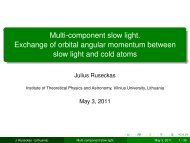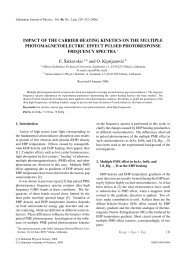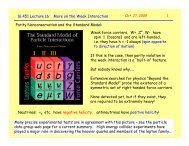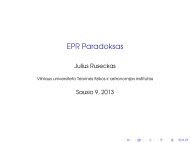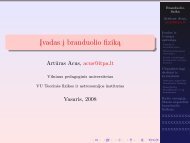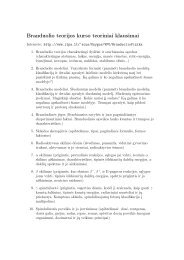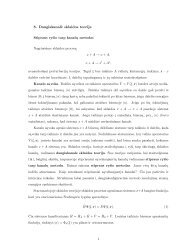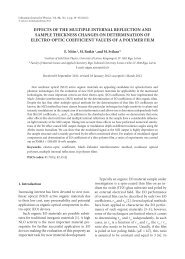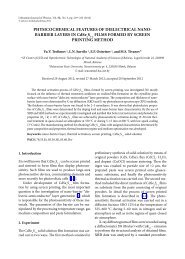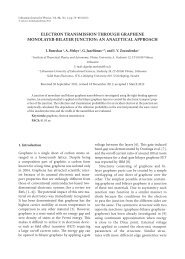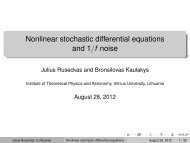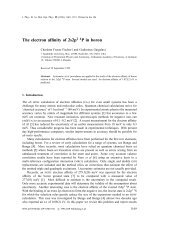DIELECTRIC DISPERSION IN 1,2-DIAMINOPROPANE ...
DIELECTRIC DISPERSION IN 1,2-DIAMINOPROPANE ...
DIELECTRIC DISPERSION IN 1,2-DIAMINOPROPANE ...
Create successful ePaper yourself
Turn your PDF publications into a flip-book with our unique Google optimized e-Paper software.
314<br />
P. Undre and P. W. Khirade / Lith. J. Phys. 51, 313–323 (2011)<br />
frequency dependent dielectric behaviour of solvent<br />
mixtures provides information on molecular<br />
interactions and mechanism of molecular processes.<br />
The dielectric relaxation behaviour of mixtures<br />
of polar molecules under varying conditions<br />
of compositions is very important as it helps in obtaining<br />
information about relaxation processes in<br />
mixtures.<br />
Becker et al. [3] carried out a systematic study<br />
of dielectric relaxation of monohydric alcohol with<br />
dihydric alcohols (diols) solutions at 293 K over<br />
the frequency range of 5 MHz to 72 GHz using<br />
the lumped circuit, coaxial and waveguide method.<br />
The principal component, which is related to the<br />
dynamics of self- and/or hetro-association, is discussed<br />
with respect to steric conditions. In mixtures<br />
of monohydric (1-butanol) with longer chain 1,2-<br />
diols, the principal relaxation time passes through a<br />
minimum on increasing the dihydroxy content. In<br />
mixtures of tert-butanol (which has a weaker selfassociation<br />
tendency) with longer chain 1,n-diols,<br />
on the other hand, it passes through a maximum.<br />
With regard to the principal relaxation strength,<br />
longer chain 1,2-diols tend to resemble monohydric<br />
alcohols of full diol chain length while 1,n-diol<br />
tends to resemble monohydric alcohol of half the<br />
diol chain length.<br />
Sengwa et al. [4] studied the dielectric relaxation<br />
in propylene glycol–poly propylene glycol mixtures<br />
over three concentrations in the frequency range<br />
10 MHz to 4 GHz at 298 K using Time Domain<br />
Reflectometry (TDR). The effective Dielectric relaxation<br />
is shown to depend exponentially on the<br />
number density of dipoles or molecules. Puranik<br />
et al. [5] studied the dielectric properties of ethanol<br />
and ethylene glycol using TDR techniques in<br />
the frequency range of 10 MHz to 10 GHz over the<br />
temperature range 243–313 K. The activation energies<br />
of both systems are compared.<br />
Hanna et al. [6] carried out a dielectric relaxation<br />
study of monohydroxy–dihydroxy alcohols binary<br />
and monohydroxyl–diol-diol ternary mixtures at<br />
293 K over the frequency range from 10 MHz to<br />
10 GHz using the TDR technique. An apparent dipole<br />
moment term and the effective relaxation time<br />
of the main dispersion region are given as a function<br />
of the number density of dipoles.<br />
To compare the influence of different polar<br />
groups in the relaxation mechanism, we have considered<br />
it interesting to perform an analogous treatment<br />
such as that carried out for binary mixture<br />
of primary alcohols-diol, dio-diol. For this reason,<br />
dielectric dispersion study in 1,2-diaminopropane<br />
(DP) with dimethylaminoethanol (DMAE) mixtures<br />
over the frequency range of 10 MHz to 20 GHz<br />
has been carried out using pico-second TDR. The<br />
binary system of DP–DMAE has been selected to<br />
understand the effect of amino and methyl sidegroup<br />
on the dielectric parameters, where the significance<br />
is based upon the tetrahedric nature of the<br />
–NH 2<br />
group. This extreme is of decisive relevance<br />
for the process of chemical synthesis, the behaviour<br />
of amino acids and proteins in biochemical models<br />
related to biogenic amines which contribute to the<br />
mechanism of electrical conduction in the nervous<br />
system, especially in nurotransmission.<br />
This binary system of DP and DMAE is of interest<br />
because of two functional groups in both<br />
components with one common –NH 2<br />
group. The<br />
four sites available for H-bonding in a DP molecule<br />
promote a set of transient cross links between<br />
neighbouring molecules. In such a case, relevant<br />
transient structures such as branched associated<br />
species and/or chains are formed. In addition, many<br />
conformations can be generated for each molecule<br />
by the rotation of CH 2<br />
NH 2<br />
group around the C–C<br />
axis with respect to H 2<br />
N–CH–CH 3<br />
group. DMAE<br />
is a hydroxylamine, tertiary amine, versatile and<br />
polyfunctional molecule that combines the characteristics<br />
of amines and alcohols and is capable of<br />
undergoing reactions typical of both alcohols and<br />
amines. Competition for H-bond site governs the<br />
nature of short-range order around molecules of<br />
both components of the solvent mixture. For the<br />
hydroxyamines, this is the dominant feature. The<br />
molecules of DMAE exist in intermolecular hydrogen<br />
bonded form with the rotation of CH 2<br />
N–<br />
(CH 3<br />
) 2<br />
group around C–O bond in dynamic equilibrium.<br />
The dielectric study of the binary system<br />
of these DP and DMAE molecules will give information<br />
about interaction between OH–NH 2<br />
and<br />
NH 2<br />
–NH 2<br />
group thereby forming different types of<br />
structures.<br />
Due to good solubility of DP in DMAE, these<br />
molecules may form a variety of clusters due to inter-<br />
and intra-molecular hydrogen bonds, depending<br />
on the molecular geometry of individual molecules,<br />
and hence, it is interesting to investigate the<br />
variation in the shapes of the dielectric relaxation<br />
curves of the DP–DMAE system with concentration.



